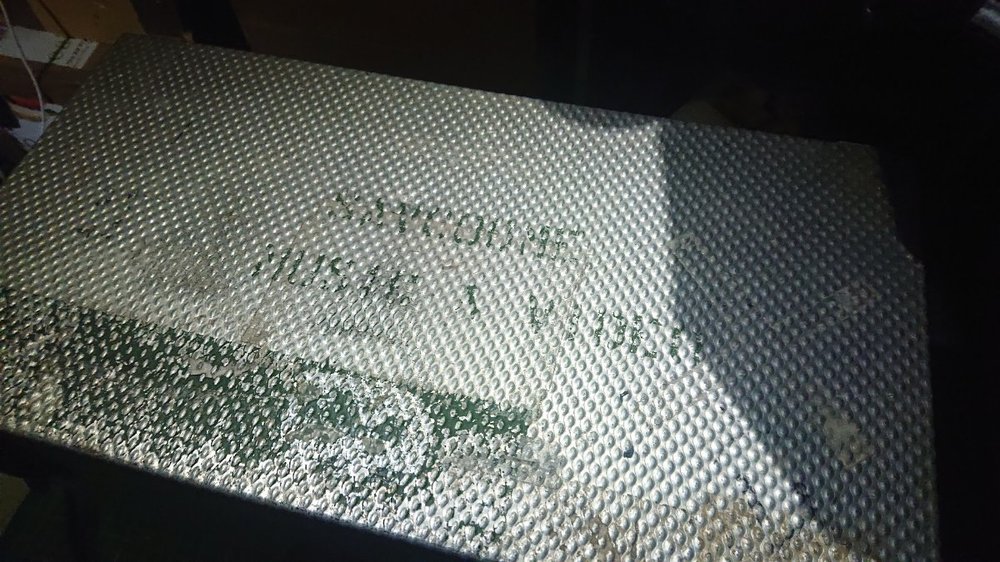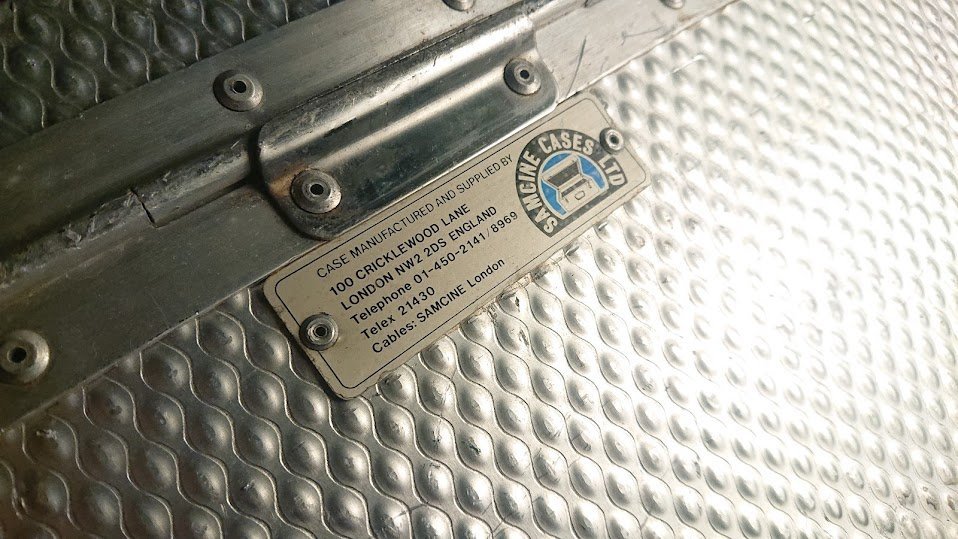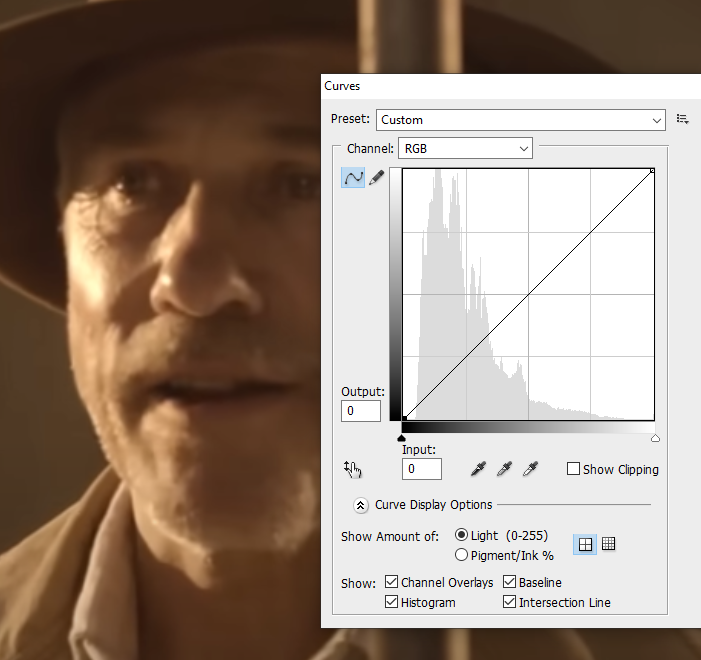-
Posts
13,757 -
Joined
-
Last visited
Everything posted by Phil Rhodes
-

I bought a used equipment case. It is very old.
Phil Rhodes replied to Phil Rhodes's topic in General Discussion
It was all a bit before my time, but I know the name. That address on Cricklewood Lane is now one of the halls of residence for Middlesex University, a building which itself doesn't look like it was built that recently, so I guess the company has been gone for decades. This thing has a few unoccupied holes in it, which suggests it's seen a few different uses over the years. There were a few scraps of foam suggesting it had been used to store a set of substantially flat objects that could be held in slots. It's odd, because the handle is on what feels like the side, and the feet are on what therefore feels like the back. I'm going to put a camera in it which I'd rather not roll on its side to move around, and I'm pondering relocating the handle to the lid, but I guess then the whole thing is dependent on the drawbar latches to avoid falling open while being carried. I am currently attacking the tape goo with various harsh solvents. Could it be forty years' worth? -

Flower blooming and wilting time lapse
Phil Rhodes replied to Phil Rhodes's topic in Camera Operating & Gear
That is a good idea. I'd like to see it open up from its supplied state, which will require it being in water, but if I can drain the water (without moving the flower!) it should then wilt fairly quickly. Possibly, although we're sort of in a "we've got what we've got" situation. -
-
Presumably, yes. I wonder if they went down Northumberland Avenue and along the North Bank. Presumably we'll find out if they do the same thing next year.
- 11 replies
-
- 1
-

-
- queen elizabeth ii
- yousuf karsh
-
(and 4 more)
Tagged with:
-
Pretty clearly taken from the roof of the Grand Building (not to be confused with the Grand Hotel, opposite), looking southwest almost up the Mall. Building at top centre is Uganda House, now (and possibly then) the location of the Ugandan High Commission. What doesn't make quite so much sense is why the procession didn't immediately turn right down Whitehall, which would be the fastest route to Westminster Abbey. That's the turning with the row of people standing across it. Any other route makes almost no sense. Likely location of photographer is about here, given the flag-waving enthusiast at the bottom right.
- 11 replies
-
- queen elizabeth ii
- yousuf karsh
-
(and 4 more)
Tagged with:
-

Bad cinematography, bad direction.
Phil Rhodes replied to Adam Frisch FSF's topic in On Screen / Reviews & Observations
It looks a lot better if you clamp the black level back down. It doesn't solve all the problems, of course, but look how sat up it is. Dubiously competent post production, I fear. To be fair, it is quite easy to accidentally do that when preparing things for YouTube and similar, but it'd be very much in the category of schoolboy errors. -
I may have to shoot a timelapse of a flower which needs to start off fairly undeveloped, bloom, and wilt. This'll take - what - a good week, I'd have thought? The finished sequence probably only needs to be under a minute, which is 1440 frames; assuming a week that's a frame every seven minutes, though I'd be keen to shoot more than that if I can find a big enough flash card, then things which may happen unexpectedly quickly will still have enough frames. This is likely to involve something like a Canon 7D. Needless to say, I'll need to set things up with mains power, completely consistent lighting, lenses that don't suffer iris bounce, and as much physical stability as possible - and resist the urge to poke at it. I've shot some timelapse before, but mainly sunrises and things that take only a few hours. Naturally, given the time involved, I'm keen not to make too many schoolboy errors. Any advice gratefully received.
-
This is a complex one but suffice to say that a lot of different sensor layouts and arrangements have been tried over the years and the upshot has been a resounding meh. Sensitivity and colour performance are to some degree a zero some game at any point. I would say we now have more sensor performance than we really need in order to make it clear that this doesn't really matter very much anymore.
-

Water / Caustics Lighting FXs Suggestions
Phil Rhodes replied to Adrian Sierkowski's topic in Lighting for Film & Video
I'm not sure anyone makes something like that which could be strapped onto a Bowens mount... And yes, all's well. I met our hat-wearing desert acquaintance when she visited London recently. Now in France. Grew tired of Tinseltown, I'm told. -

Water / Caustics Lighting FXs Suggestions
Phil Rhodes replied to Adrian Sierkowski's topic in Lighting for Film & Video
Any profile and, er, find a couple of pieces of bathroom window glass and, er, a couple of lazy susans and, er, some sort of motor arrangement and... Rosco has one, too. -

Water / Caustics Lighting FXs Suggestions
Phil Rhodes replied to Adrian Sierkowski's topic in Lighting for Film & Video
Big video projector? Use something fairly mundane with a tray of water and bounce it with a big mirror? Depending how realistic you want it, one of those cheesy old rotating glass effects on more or less any profile, with the wibbly glass disc? I have one of those somewhere. -

Does anyone else prefer the look of 2K to 4K?
Phil Rhodes replied to M Joel W's topic in General Discussion
This is why people like very mild diffusion, very slightly mushy lenses, and so on. It's all just habituation, but narrative cinema is about presenting reality behind a subtle but impenetrable layer of... Something. What that means varies but we've spent the last few years gently wrestling with the constant push for technical improvement against the need to maintain that layer of something. -
Hello. Is it possible, mechanically and geometrically, to build something like the Kipon 0.7x booster for Pentax 67 or other comparable medium-format lenses that would work with PL or EF mounts? Presumably since it doesn't seem to exist (or I'm wildly mis-googling) the answer is no; I notice they exist for LPL and RF, so presumably there isn't enough clearance. Looks like there sort of should be, though. Anyone?
-

Question about Aperture LED vs HMI's comparison
Phil Rhodes replied to Kyle Farscht's topic in Lighting for Film & Video
Everything you say is absolutely right, with the possible exception of this. Most LEDs are light and fast, but the really big, high-power LEDs are getting pretty chunky. A full Aputure 600C kit weighs more than twice what an Arri 575W HMI fresnel does, although the HMI doesn't come in a nice padded rolling case. The 600C does a lot more but it is not a featherweight either in the lamp head or the ballast. Part of this may be due to Aputure very clearly beefing up its build quality, probably in the knowledge that these things are much more targeted at a higher end market. Of course it's also less than half the price of an Arri D5, which is an increasingly absurd reality. -

Blur with focus on infinity - Scottish Landscape filming
Phil Rhodes replied to Chloe Charlton's topic in General Discussion
Ah, yes. I tried very hard not to miss what I was missing, but I missed that. Very good spot. -
What he said.
-

Blur with focus on infinity - Scottish Landscape filming
Phil Rhodes replied to Chloe Charlton's topic in General Discussion
That looks far enough away to be effectively infinity. What sort of camera and lens was this? If it's a reflex viewfinder, is the problem visible in the viewfinder? Is any part of the viewfinder image sharp? This can arise from a number of sources: - The flange focal distance is perhaps not correct. Simply put, the lens has to be an extremely precise distance away from the film for focus to work as expected (to within something like the width of a human hair). The mounting surface on the back of the lens and the lens mount on the camera must be very accurately positioned. Is there anything stuck to the mount, any damage? Did anything get stuck between the lens and the mount? What sort of mount is it? Was it properly and firmly attached? You can test this to an extent by verifying that the lens accurately (and I mean accurately) focuses to the expected distance otherwise. This will require a measuring tape to establish. Do it at a wide aperture to minimise depth of field and measure a few distances. Make sure you're measuring from the right point, which is where the film is inside the camera body. - Is this a zoom lens? Some zoom lenses have internal controls to set up tracking, which ensures the lens stays in focus as you zoom in and out. Normally that's a problem with broadcast TV lenses, though. Zooms can break in other ways which cause focus problems. If it's a zoom, does the focus appear to change as you zoom in and out? It shouldn't. Again, test. - The lens may be allowing the focus to move beyond infinity, which means nothing will be in focus. If you look at the markings on the lens barrel, do they appear to let things move beyond infinity? That can be an issue; infinity is not necessarily just a matter of turning the ring as far as it goes. In an ideal world, the lens should mechanically prevent this from happening, but sometimes they don't. - Was this shot at a very high f-stop? I see it's a day exterior presumably with lots of light. What film stock did you use, and what sort of filters, if any? Lenses have a diffraction limit which can mean fuzzy pictures at very high f-numbers. That does have a fairly specific sort of look to it, though, and this does look more like a conventional focus problem. - Did you shoot anything else with similar problems, whether set to infinity or not? - Did you use any diopters (close-up lenses) on any part of the shoot? Is it possible one of them was left in place? That might cause this. Notice several of these problems would imply a problem with the lens, so if you can only send one thing off to be looked at, send the lens off. I know it's ruinously expensive but if you can do some tests on film to make sure someone didn't make some sort of daft mistake on the day, test again to make sure this is really happening and is a repeatable problem. Once you're convinced it is, it'll have to go off to be fixed. Has this camera and lens been maintained recently? Phil -

Question about Aperture LED vs HMI's comparison
Phil Rhodes replied to Kyle Farscht's topic in Lighting for Film & Video
I have some Aputure 600-watt LEDs available right now, so if you want any measurements done I'm happy to oblige. Generally they seem powerful because, with the high-gain reflectors, they are effectively PARs. It's a high-efficiency layout. They do quite well with the spotlight adapter, too, because the profile lens tube is pretty well designed and nicely put together. There is an argument that Aputure's fresnel isn't quite large enough and perhaps fails to capture as much of the light output by the COB as it could, though it's not clear how much difference that makes compared to a 575W HMI with its small lens. It's worth noticing that all of these things are actually more to do with the adaptors that go on the front than the light itself. The point is that it's relatively easy to gather all of the light that comes out of the LED module because it isn't radiating light into a near-spherical pattern. It's easier to push the photons in a useful direction. The system is less lossy. As such, these modern LED designs are all likely to be more efficient, watt for watt, than HMIs, for no reason other than that they let people create more optically efficient designs. The absolute efficiency of an LED with reasonable colour quality is probably not that much larger than an HMI, although for me the deciding factor has to be cost. An Arri D5 575W HMI PAR with ballast is more than twice the price of an Aputure LS 600C, and the 600C is a full colour mixing, dimmable, interchangeable-modifier light that can in a pinch be run from batteries. Expensive batteries, sure, but it can be done. I would also say that the 600D Pro (which is the beefier, better-built, roadworthy version) and the 600C Pro are both reasonably representative of Aputure upping its game and targeting a higher end clientele. On that basis, I wonder if some of the big players in this industry will go the way of, say, DaVinci, which gurgled down the plughole with a shriek of "but we're high end, this can't happen to us!" -
So where do I find this COFDM thing? As far as I was aware the Amimon tech is a QAM approach with clever allocation to minimise the impact of errors. P
-
Ah, Nyrius! Mine died a while ago but served well for a while. I have a Bolt 4K 1500 here if anyone wants me to run any tests. Can't remember how much power the transmitter pulls.
-
Has anyone used the wheel accessories for modern remote heads and gimbals? Are the skills transferable? One would have hoped so.
-

In Camera effects - Prisms, Glass...
Phil Rhodes replied to Boris Kalaidjiev's topic in General Discussion
Or hit the charity shops* for old bits of cut glass tableware. * Thrift stores, Americans -

In Camera effects - Prisms, Glass...
Phil Rhodes replied to Boris Kalaidjiev's topic in General Discussion
Spare chandelier parts! http://www.uk.thechandeliercompany.com/section.php/911/1/crystal-and-glass-pieces







